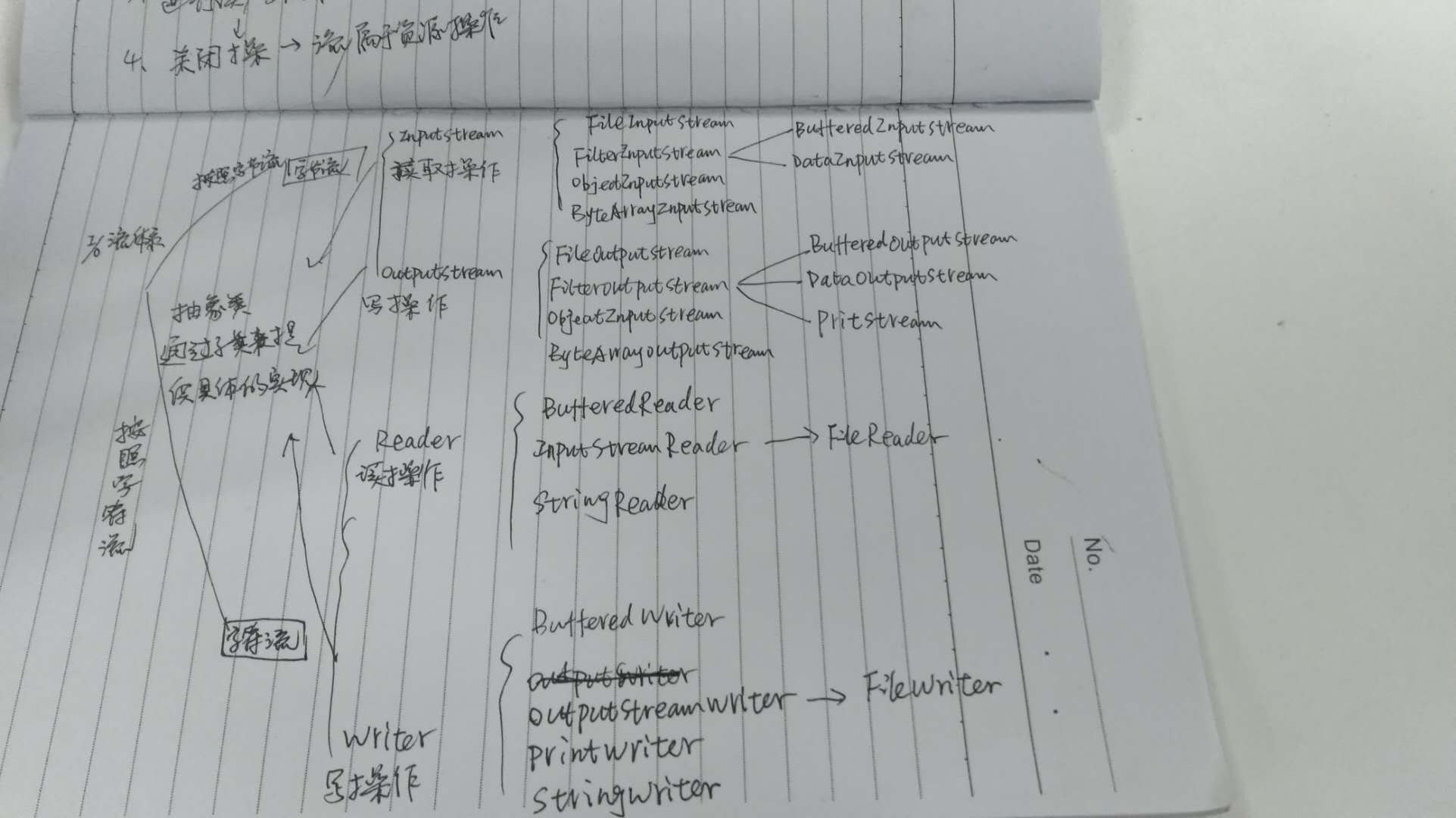java基础之-I/O流和File类解析
在日常的java开发中少不了文件的读取和 写入,这就涉及到文件的I/O操作,今天就来总结下文件的IO操作,顺便文件的IO操作也需要File了的帮助,所以一起总结了。
以下图片为我根据其他博客所总结的内容进行了相应的总结和IO流的类结构图,类结构图中还少了几个类
简单描述下:
IO分为字节和字符流2中方式,字节流以byte为单位,字符流以字符为单位,1个字节8byte 0·255,字节流的抽象类为inputstream和outputstream,他们无法实例化,所以需要
其子类来实现。字符流通常按2个字节来表示则为16byte,字符流的抽象类为reader和writer。
字符流通常是需要将文件读取到内存才能进行操作的,而字节流则是直接操作文件的。


还是通过具体的例子来说明吧。
@Test
public void testFileReader() throws IOException {
File file = new File("D:/train/train.txt");
FileInputStream fs = new FileInputStream(file);
InputStreamReader reader = new InputStreamReader(fs,"utf8");
BufferedReader bufferedReader = new BufferedReader(reader);
System.out.println(bufferedReader.readLine());
// 关闭文件流
bufferedReader.flush(); bufferedReader.close();
reader.close();
fs.close();
} @Test
public void testFileOut() throws IOException {
File file = new File("D:/train/train.txt");
FileOutputStream out = new FileOutputStream(file);
String str = "hello world";
out.write(str.getBytes("utf8"));
out.close();
}
上面的代码包含了文件的读取和文件的写入,包含字符集设置,读取操作其实可以包含了IO中绝大多数的操作了。需要注意的是不管是字节流,还是字符流他们的read()方法返回的结果都是int类型,需要将其转换成char类型。具体的源码可以根据类的结构树去查看。
一上为简单总结了IO流,下面是File类的总结:



File -> FileSystem -> WinNTFileSystem
操作文件其实通过操作系统的文件功能来实现的,不同的系统如windows和UNIX其实是不同的,新建的File通过getFileSystem()方法获取系统操作文件的权限,每个新建的文件都包含2个重要参数path和prefixLength
/**
* This abstract pathname's normalized pathname string. A normalized
* pathname string uses the default name-separator character and does not
* contain any duplicate or redundant separators.
* 这个抽象路径的正常路径名称,"d:/program file/train"这种格式
* @serial
*/
private final String path; /**
* The length of this abstract pathname's prefix, or zero if it has no
* prefix. 抽象路径的前缀长度,不存在则为0
*/
private final transient int prefixLength;
文件系统的操作其实很多都是通过这个前缀来创建文件的。
通过看源码可以发现,File类其实有点像接口,而WinNTFileSystem类则像实现接口。
看下File的构造函数,其中通过uri的构造函数没有贴出,有需要可以自己去查阅
/**
* Creates a new <code>File</code> instance by converting the given
* pathname string into an abstract pathname. If the given string is
* the empty string, then the result is the empty abstract pathname.
*
* @param pathname A pathname string
* @throws NullPointerException
* If the <code>pathname</code> argument is <code>null</code> 最通用给构造函数,通过文件路径来创建文件
*/
public File(String pathname) {
if (pathname == null) {
throw new NullPointerException();
}
this.path = fs.normalize(pathname);
this.prefixLength = fs.prefixLength(this.path);
} /**
* Creates a new <code>File</code> instance from a parent pathname string
* and a child pathname string.
*
* <p> If <code>parent</code> is <code>null</code> then the new
* <code>File</code> instance is created as if by invoking the
* single-argument <code>File</code> constructor on the given
* <code>child</code> pathname string.
*
* <p> Otherwise the <code>parent</code> pathname string is taken to denote
* a directory, and the <code>child</code> pathname string is taken to
* denote either a directory or a file. If the <code>child</code> pathname
* string is absolute then it is converted into a relative pathname in a
* system-dependent way. If <code>parent</code> is the empty string then
* the new <code>File</code> instance is created by converting
* <code>child</code> into an abstract pathname and resolving the result
* against a system-dependent default directory. Otherwise each pathname
* string is converted into an abstract pathname and the child abstract
* pathname is resolved against the parent.
* 通过父路径和子路径来创建文件
* @param parent The parent pathname string
* @param child The child pathname string
* @throws NullPointerException
* If <code>child</code> is <code>null</code>
*/
public File(String parent, String child) {
if (child == null) {
throw new NullPointerException();
}
if (parent != null) {
if (parent.equals("")) {
this.path = fs.resolve(fs.getDefaultParent(), -->"/"
fs.normalize(child));
} else {
this.path = fs.resolve(fs.normalize(parent),
fs.normalize(child));
}
} else {
this.path = fs.normalize(child);
}
this.prefixLength = fs.prefixLength(this.path);
} /** 通过父文件和子路径来创建文件
* Creates a new <code>File</code> instance from a parent abstract
* pathname and a child pathname string.
*
* <p> If <code>parent</code> is <code>null</code> then the new
* <code>File</code> instance is created as if by invoking the
* single-argument <code>File</code> constructor on the given
* <code>child</code> pathname string.
*
* <p> Otherwise the <code>parent</code> abstract pathname is taken to
* denote a directory, and the <code>child</code> pathname string is taken
* to denote either a directory or a file. If the <code>child</code>
* pathname string is absolute then it is converted into a relative
* pathname in a system-dependent way. If <code>parent</code> is the empty
* abstract pathname then the new <code>File</code> instance is created by
* converting <code>child</code> into an abstract pathname and resolving
* the result against a system-dependent default directory. Otherwise each
* pathname string is converted into an abstract pathname and the child
* abstract pathname is resolved against the parent.
*
* @param parent The parent abstract pathname
* @param child The child pathname string
* @throws NullPointerException
* If <code>child</code> is <code>null</code>
*/
public File(File parent, String child) {
if (child == null) {
throw new NullPointerException();
}
if (parent != null) {
if (parent.path.equals("")) {
this.path = fs.resolve(fs.getDefaultParent(),
fs.normalize(child));
} else {
this.path = fs.resolve(parent.path, --> 将父文件转换成路径,然后和子路径拼接
fs.normalize(child));
}
} else {
this.path = fs.normalize(child);
}
this.prefixLength = fs.prefixLength(this.path);
}
其他的一些方法如创建新文件,creatNewFile(),创建文件夹mkdir(),mkdirs()等方法,相信看下源码就能很清楚了。
java基础之-I/O流和File类解析的更多相关文章
- java基础9(IO流)-File类
File类 File:文件和目录路径名的抽象表示形式.即java中把文件或者目录都封装成File对象 代码练习1 import java.io.File; public class FileDemo1 ...
- 【Java基础】【19异常&IO(File类)】
19.01_异常(异常的概述和分类) A:异常的概述 异常就是Java程序在运行过程中出现的错误. B:异常的分类 通过API查看Throwable Error 服务器宕机,数据库崩溃等 Except ...
- IO流,File类的测试........课堂加总结
package liu0926; import java.io.File; import java.io.IOException; public class Text01 { public stati ...
- Java基础系列2:深入理解String类
Java基础系列2:深入理解String类 String是Java中最为常用的数据类型之一,也是面试中比较常被问到的基础知识点,本篇就聊聊Java中的String.主要包括如下的五个内容: Strin ...
- java基础——IO流之File类
1.File类的构造方法: File(String pathName):通过一个指定的字符串类型路径来创建一个文件对象 File (String parent,String child):通过指定 ...
- Java基础系列8——IO流超详细总结
该系列博文会告诉你如何从入门到进阶,一步步地学习Java基础知识,并上手进行实战,接着了解每个Java知识点背后的实现原理,更完整地了解整个Java技术体系,形成自己的知识框架. 在初学Java时,I ...
- Java基础之详谈IO流
Java基础知识.IO流详细讲解.你所要的IO这里都有
- Java笔记(二十七)……IO流中 File文件对象与Properties类
File类 用来将文件或目录封装成对象 方便对文件或目录信息进行处理 File对象可以作为参数传递给流进行操作 File类常用方法 创建 booleancreateNewFile():创建新文件,如果 ...
- -1-4 java io java流 常用流 分类 File类 文件 字节流 字符流 缓冲流 内存操作流 合并序列流
File类 •文件和目录路径名的抽象表示形式 构造方法 •public File(String pathname) •public File(String parent,Stringchild) ...
随机推荐
- Windows系统ping本地虚拟机~
虚拟机左上角[编辑]>>>[虚拟网络编辑器] [VMnet1]>>>子网ip:192.168.124.0 子网掩码:255.255.255.0 [VMnet8]&g ...
- Kafka系列2-producer和consumer报错
1. 使用127.0.0.1启动生产和消费进程: 1)启动生产者进程: bin/kafka-console-producer.sh --broker-list 127.0.0.1:9092 --top ...
- grep 及正则表达式
grpe 及正则表达式 文本查找的需要:grep,egrep,fgrepgrep: 根据模式,搜索文本,并将符合模式的文本行显示出来.Pattern : 文本字符以及正则表达式的元字符组合而成的匹配条 ...
- python3 购物车
今天干了啥?喂了喂龟,看了看鱼... 然后就是学习了两个模块:sys模块和os模块,突然觉得python真的好,只要英语学的好,看代码超级舒服的说,嗯,我要好好学英语,今天背了几个啥,唉.写完博客再背 ...
- 百度APP移动端网络深度优化实践分享(一):DNS优化篇
本文由百度技术团队“蔡锐”原创发表于“百度App技术”公众号,原题为<百度App网络深度优化系列<一>DNS优化>,感谢原作者的无私分享. 一.前言 网络优化是客户端几大技术方 ...
- android学习笔记--Scanner
private static List<String> getxxxx(Context ctx) { try { Scanner sc = new Scanner( ctx.openFil ...
- 【工利其器】必会工具之(一)Source Insight篇
前言 “Source Insight(以下简称SI)是世界上最好的编辑器”,说这句话不知道会不会出门被打呢?-_- 中国古话说得好,“文无第一,武无第二”,所以不敢说SI是最好的,但是 ...
- 前端CSS学习-Background背景相关
在CSS中 背景属性用于定义HTML元素的背景. background主要设置一下五个属性: background-color // 设置元素的背景颜色. background-image // 把 ...
- pwnable.tw applestore 分析
此题第一步凑齐7174进入漏洞地点 然后可以把iphone8的结构体中的地址通过read修改为一个.got表地址,这样就能把libc中该函数地址打出来.这是因为read函数并不会在遇到\x00时截断( ...
- 取之有道——巧用Root权限 启动其他APP中的Activity
这次博主来分享一个很巧妙的办法来启动其他APP中Activity的方法. 首先说一下这样做的目的:最近博主在攻克一个技术难点,就是搞定某些三方系统中,对于应用权限的限制.为此给出用户指导,引导用户启动 ...
